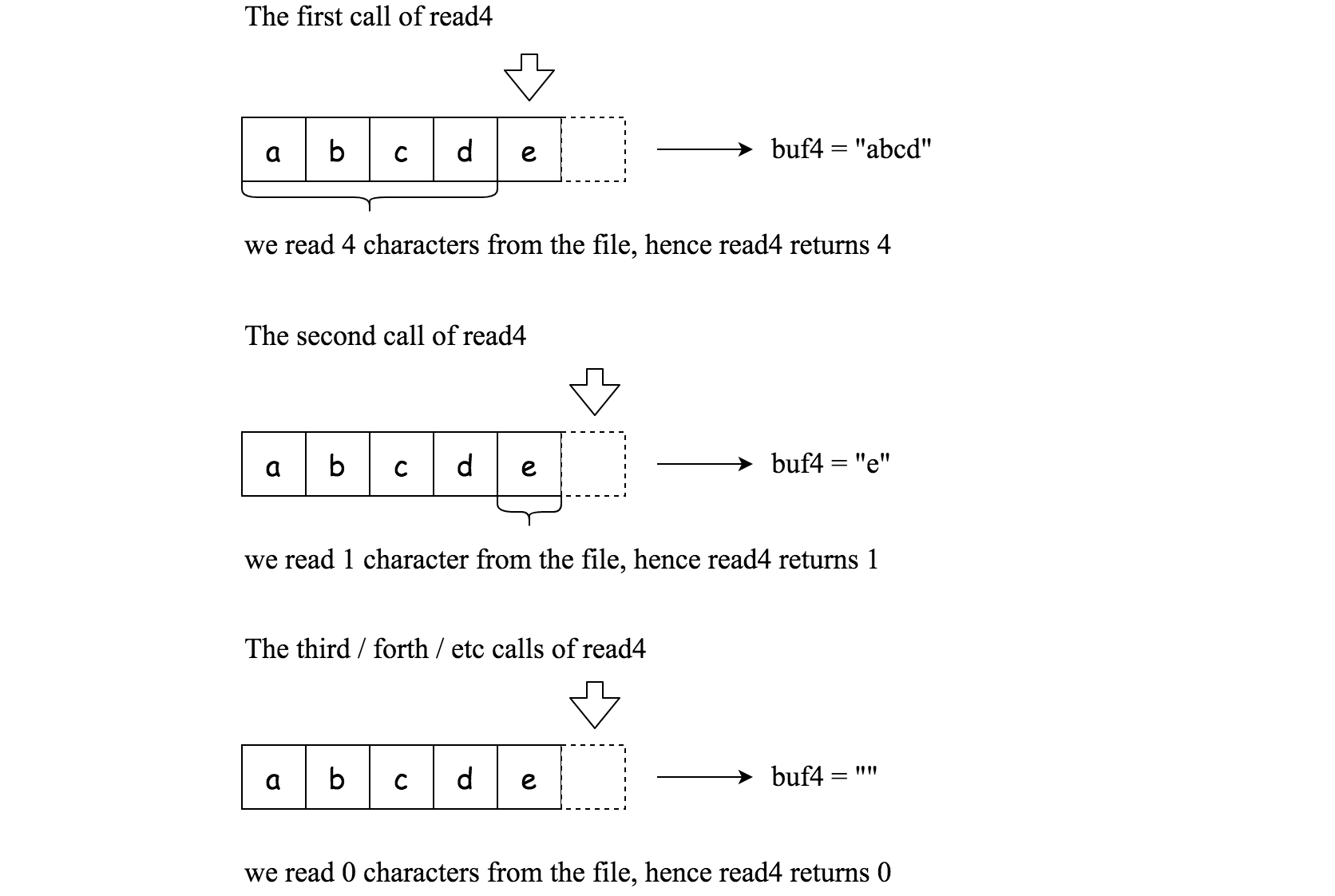Given a file and assume that you can only read the file using a given method read4, implement a method to read n characters.
Method read4:
The API read4 reads 4 consecutive characters from the file, then writes those characters into the buffer array buf.
The return value is the number of actual characters read.
Note that read4() has its own file pointer, much like FILE *fp in C.
Definition of read4:
Parameter: char[] buf4 Returns: int Note: buf4[] is destination not source, the results from read4 will be copied to buf4[]
Below is a high level example of how read4 works:

File file("abcde"); // File is "abcde", initially file pointer (fp) points to 'a' char[] buf4 = new char[4]; // Create buffer with enough space to store characters read4(buf4); // read4 returns 4. Now buf = "abcd", fp points to 'e' read4(buf4); // read4 returns 1. Now buf = "e", fp points to end of file read4(buf4); // read4 returns 0. Now buf = "", fp points to end of file
Method read:
By using the read4 method, implement the method read that reads n characters from the file and store it in the buffer array buf. Consider that you cannot manipulate the file directly.
The return value is the number of actual characters read.
Definition of read:
Parameters: char[] buf, int n
Returns: int
Note: buf[] is destination not source, you will need to write the results to buf[]
Example 1:
Input: file = "abc", n = 4 Output: 3 Explanation: After calling your read method, buf should contain "abc". We read a total of 3 characters from the file, so return 3.
Note that "abc" is the file's content, not buf. buf is the destination buffer that you will have to write the results to.Example 2:
Input: file = "abcde", n = 5 Output: 5 Explanation: After calling your read method, buf should contain "abcde". We read a total of 5 characters from the file, so return 5.Example 3:
Input: file = "abcdABCD1234", n = 12 Output: 12 Explanation: After calling your read method, buf should contain "abcdABCD1234". We read a total of 12 characters from the file, so return 12.Example 4:
Input: file = "leetcode", n = 5 Output: 5 Explanation: After calling your read method, buf should contain "leetc". We read a total of 5 characters from the file, so return 5.
Note:
- Consider that you cannot manipulate the file directly, the file is only accesible for
read4but not forread. - The
readfunction will only be called once for each test case. - You may assume the destination buffer array,
buf, is guaranteed to have enough space for storing n characters.
用 Read4 读取 N 个字符。
题目定义了一个read4()函数。同时题目给了一个buffer,用来存放最终的结果,一个变量N表示要处理的字符串的总长度。请你利用read4()函数,将字符串存到buffer中。
这个题思路不难,但是我想很可能是题目表述不是很直观所以大部分人给的是downvote。注意题目的条件,给的文件file的长度其实是可长可短的,但是变量N表示的是你需要从文件中读取出N个字符。如果file长度本身就不足N,那么就返回文件本身的长度。
这个题的思路是,因为read4()函数每次只能读取4个字符,所以首先创建一个长度为4的临时数组,这样每次跑read4()函数的时候,可以把结果先存下来。然后按位一个个字符存入buffer中。因为read4()函数每次也是可以返回读到的字符串的长度的,所以当某一次read4()函数返回一个小于4的结果,就知道这个字符串快到末尾了,此时记得要break即可。
时间O(n)
空间O(1) - 只用了一个长度固定的额外数组
Java实现
1 /** 2 * The read4 API is defined in the parent class Reader4. 3 * int read4(char[] buf4); 4 */ 5 6 public class Solution extends Reader4 { 7 /** 8 * @param buf Destination buffer 9 * @param n Number of characters to read 10 * @return The number of actual characters read 11 */ 12 public int read(char[] buf, int n) { 13 char[] temp = new char[4]; 14 int i = 0; 15 int pointer = 0; 16 while (i < n) { 17 int len = read4(temp); 18 pointer = 0; 19 while (i < n && pointer < len) { 20 buf[i] = temp[pointer]; 21 i++; 22 pointer++; 23 } 24 if (len < 4) { 25 break; 26 } 27 } 28 return i; 29 } 30 }